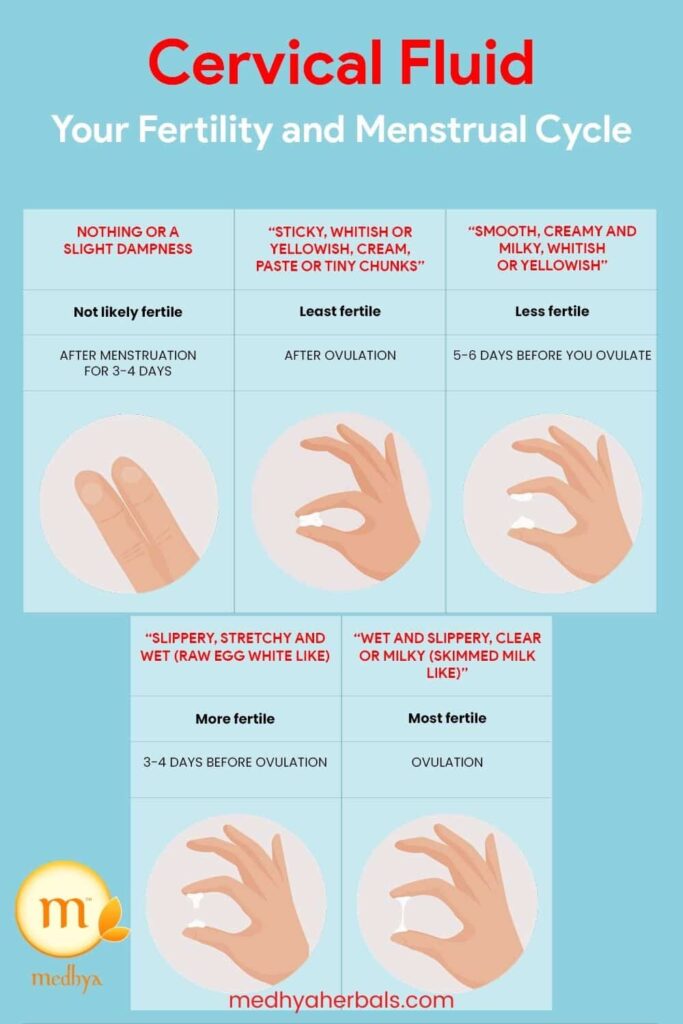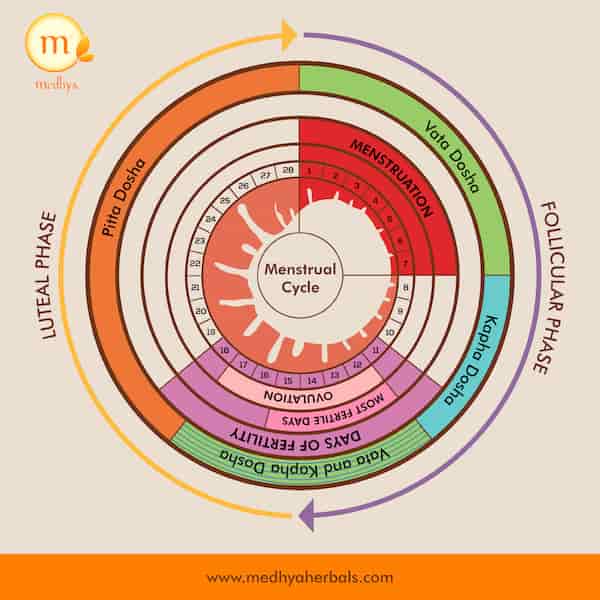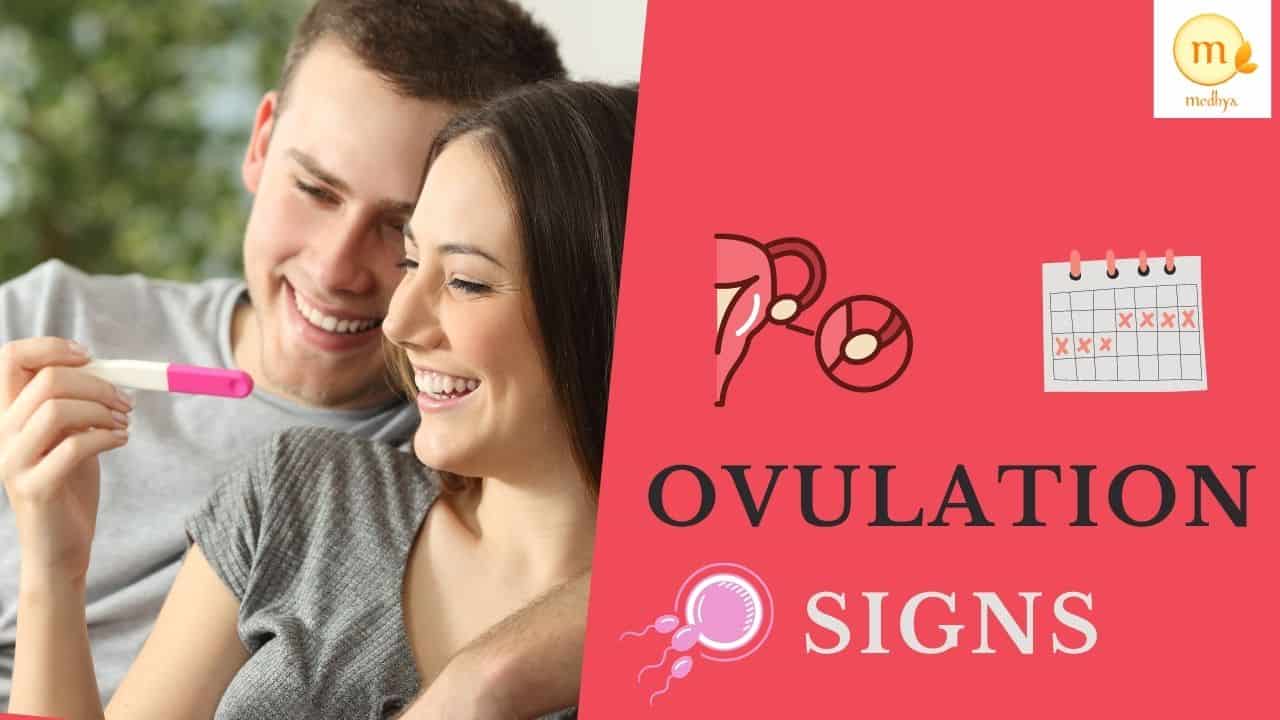Ovulation signs usually accompany you midway through your menstrual cycle. It can bring a lot of hope and joy, if you are planning for pregnancy. And if you are not, yet knowing about ovulation symptoms and signs will help you to better predict your menstrual cycle.
In any case, ovulation signs indicate fertility, a healthy menstrual cycle, good health of your reproductive system, and endocrine system. And of course, knowing about them adds a lot of comfort and ease of knowing your own body.
In this post, we will look physiological changes that happen in your body during ovulation. This will help you to know of the ovulation signs and track it better.
Let’s begin this the good old classic way: by defining ovulation.

What is Ovulation?
Ovulation is the stage of your menstrual cycle, when an egg is actually released from the ovary. It travels down through the Fallopian tubes to the uterus.
Ovulation usually happens nearly midway of the cycle. However, this is highly variable and actual time of ovulation varies from woman to woman. Exact timing of ovulation is also affected by multiple lifestyle factors; stress being one of them (in modern our life’s context).
For example, if you have gone through period of physical or mental stress; it may actually delay or even prevent you from ovulating in that particular cycle.
However, if everything stays normal. And of course your health is in good state, then ovulation can happen between days 12 and 21, depending on the length of your cycle.
Pro Tip: Once, you start tracking ovulation. You will get better handle on your fertility and periods. So, keep a track of your ovulation day for 2-3 months before you actually plan to conceive.
How long does Ovulation Last?
What’s the big deal about tracking ovulation anyway? Well, the thing is, if you really want to get pregnant, you should know when you ovulate. After all, if you don’t ovulate, there will be no egg to be fertilized.
Mature egg is released from the ovaries after a surge in LH (Luteinizing Hormone) takes place. Usually, ovulation can happen anywhere between 12 to 24 hours after LH increases.
Ovulation only happens once every cycle. This means, each month, you only have one shot at it. The lifetime of the egg after it is released is up to 24 hours. After this time, it cannot be fertilized and readily disintegrates.
But, its not the same for a sperm. A healthy sperm can survive in a healthy cervical fluid for up to 5 days. Also, sperm can travel as far as till the end of Fallopian tubes to meet the egg. That’s why, even if you have had sex few days before you ovulate, you can still conceive!
So, your fertile period is determined mainly by when you ovulate. If you know when you ovulate, then you know when you have the best chance of getting pregnant.
What are the signs of ovulation?
How do I know when I’m ovulating?
Well, thankfully, the body does tell you. It sends these subtle messages that you might not catch if you are not looking for them. These messages are in the form of changes that take place in the body as you approach ovulation.
During ovulation, many women experience a range of physical and emotional changes. Some may have increased energy levels, while others may feel tired or experiencing mood swings. Some women also notice changes in their appetite or cravings for certain foods. These changes are caused by hormonal fluctuations and are completely normal. Ovulation is an important part of a woman’s reproductive health, and understanding what happens during this time can help you better manage your own fertility.
1. Changes in the cervix
The cervix is that muscular passageway that connects the external reproductive organ (the vagina) with the womb. Around the time of ovulation, the position of the cervix shifts slightly upwards.
It also becomes softer and is more open. This is in preparation to receive sperm cells.
2. Changes in cervical mucus
There is a fluid that is usually around this cervix. It might be dry when you have just had your flow. The mucus begins to form thickly as the cycle progresses.
However, the cervical mucus lightens up as ovulation draws near. You can feel this with a clean finger.

3. Increased sexual drive
Heightened libido is another sign of ovulation. Mother Nature, in all her wisdom, has perfectly timed the events. Life must be preserved. Therefore, it is no wonder that the sex drive increases at the height of the fertile period.
This is due to the effects of hormones produced during this period of the menstrual cycle, such as the luteinizing hormone.
4. Tender Breasts and Sore Nipples
At ovulation, the level of the hormone progesterone in your body starts to increase. This can cause your breasts to become tender and your nipples to become sore. Progesterone is responsible for preparing the lining of the uterus for pregnancy. It also stimulates the growth of milk ducts in the breasts. The increased level of progesterone during ovulation makes your breasts more sensitive to both touch and temperature changes. This usually subsides after a few days, but some women may experience soreness and tenderness for the entire length of their cycle. If you find that your breasts are sore and tender during ovulation, you can try wearing a supportive bra or do hot compress for pain relief.
5. Ovulation pain
Ovulation pain, also known as mittelschmerz, is a common symptom of ovulation. It is caused by the ovary releasing the egg into the fallopian tube. The egg then travels down the fallopian tube towards the uterus.
Ovulation pain can range from mild to severe. It may be a sharp, stabbing pain or a dull, cramping pain. You may also experience pain in your lower abdomen or pelvic region. Typically, the pain is only felt on one side of the abdomen or pelvis. This is usually the side of the ovary, which is releasing the egg.
Some women also experience bloating, diarrhea, or nausea during ovulation. If you are experiencing ovulation pain, you can sip on ginger tea to reduce the intensity of pain. You can also try using a heating pad or taking a hot bath to relieve the pain.
Ovulation pain is usually nothing to worry about and will go away on its own within a few days. However, if you are experiencing severe pain or if the pain lasts for more than a few days, you should see your doctor to rule out any other possible causes.
6. Spotting During Ovulation
For some women, ovulation is accompanied by a briefer drop in estrogen levels, which can cause spotting or brownish vaginal discharge. This is completely normal and nothing to be concerned about. In fact, ovulation spotting can actually be a sign that your body is ovulating properly. If you’re trying to conceive, ovulation spotting can be a helpful way to pinpoint when you’re most fertile. However, if you’re not trying to get pregnant, ovulation spotting is still nothing to worry about. It’s perfectly normal and usually nothing to be concerned about.
7. Sensitivity to certain Smells
If you have dogs around you, then you might have heard something about dogs being on heat. A similar thing happens in humans. In this case, your sense of smell is heightened, and you are more attracted to male pheromones.
8. Ferning pattern of saliva on the Tongue
You might need a microscope to observe this.
How to Track your ovulation?
Ovulation usually occurs about midway through a woman’s menstrual cycle. For most women, this happens every 28 days or so. However, some women may experience more frequent or irregular ovulation. In addition to hormonal changes, ovulation can be affected by stress, illness, travel, and other factors.
The hormone responsible for ovulation is progesterone. It is produced in the ovaries and released into the bloodstream. Progesterone levels vary throughout the menstrual cycle, with the highest levels being reached just before ovulation.
To track your ovulation, you can use an ovulation predictor kit or use natural fertility methods that involve:
- Keep track of your cervical mucus. Just before ovulation, you may notice that your cervical mucus becomes thin, clear and stretchy.
- Measuring your basal body temperature (falls, then rises at the time of ovulation)
- Use the ovulation calendar
It could be an interesting journey trying to get pregnant. Make sure you see your doctor if something seems to be off about your ovulation. Ensure that all possible underlying problems are ruled out.
Ovulation Tests
There are a number of hormones that regulate ovulation, including follicle-stimulating hormone (FSH) and luteinizing hormone (LH). These hormones are secreted by the pituitary gland and help to control the growth and development of the ovarian follicles (which contain the eggs). As ovulation approaches, levels of FSH and LH increase, which causes the follicles to mature and release their eggs.
If you want to know for sure if you are ovulating, you can have an ultrasound or have your blood tested for LH levels (luteinizing hormone). LH levels surge just before ovulation and can be detected in urine and blood tests. An ultrasound can also show if the egg has been released from the follicle. Talk to your doctor if you want to know more about how to find out if you are ovulating.
FAQ
What happens to your body when you ovulate?
The reproductive system is designed to allow for the fertilization of an egg by sperm and the subsequent implantation of a fertilized egg in the lining of the uterus. The process by which these things happen is called ovulation. During ovulation, the ovaries release an egg (or multiple eggs) into the fallopian tubes. If sperm are present in the fallopian tubes at the time of ovulation, they may fertilize the egg. The fertilized egg then implants itself in the lining of the uterus, where it begins to grow and develop into a fetus.
Why is my ovulation painful?
There are a number of possible explanations for why your ovulation might be accompanied by pain. One possibility is that your egg is not being released from the ovary smoothly, causing inflammation and irritation. Another possibility is that you have a condition known as endometriosis, in which the tissue that lines the uterus grows outside of the uterus and can cause pain during ovulation. It’s also possible that you have a cyst on your ovary that is rupturing during ovulation, causing pain. If you’re concerned about your ovulation pain, it’s best to consult with your doctor to Rule out any serious underlying conditions. Ayurveda practitioners also recommend avoiding foods that are inflammatory, such as dairy and gluten, and eating plenty of fresh fruits and vegetables to support reproductive health.
Does spotting during ovulation mean pregnancy?
Ayurveda is an ancient system of medicine that originated in India. One of the core principles of Ayurveda is that the body is made up of three “doshas,” or energies, which are responsible for different functions. These doshas are known as Vata, Pitta, and Kapha. Ayurvedic practitioners believe that imbalances in the doshas can lead to disease. The goal of treatment is to restore balance and achieve optimal health. According to Ayurvedic medicine, ovulation is a time when the Vata dosha is elevated. This can cause a variety of symptoms, including spotting. However, it is important to note that spotting during ovulation is not indicative of pregnancy. rather, it is simply a sign that the body is out of balance. There are many ways to restore balance within the body, and Ayurvedic practitioners can help you find the best solution for you.
Can you feel when you are ovulation?
There are a few ways to tell if you are ovulating. One common sign is a change in your basal body temperature. This is your temperature when you first wake up in the morning. Ovulation usually causes a slight rise in basal body temperature. Another way to tell if you are ovulating is by tracking your cervical mucus. Just before ovulation, you may notice an increase in cervical mucus. It will be thin, watery, and clear. This is sometimes called “egg white cervical mucus.” You may also notice changes in your cervix itself. Just before ovulation, the cervix tends to be soft, high, and open. After ovulation, it becomes low, hard, and closed. Some women feel a slight twinge of pain on one side of their pelvis when they ovulate. This is called Mittelschmerz and is caused by the release of the egg from the ovary. However, not all women feel this pain.
When is the best time to try and get pregnant?
When it comes to trying to conceive, timing is everything. The best time to get pregnant is during the ovulation period, which usually occurs around day 14 of a woman’s menstrual cycle. To increase the chances of conceiving during this time, it is important to have regular intercourse and to avoid using any contraception methods that may prevent fertilization from taking place. Some couples may also find it helpful to track the woman’s cycle and use an ovulation predictor kit to help identify when ovulation is occurring. By understanding the ovulation cycle and timing intercourse accordingly, couples can increase their chances of conceiving successfully.
What time is sperm most active?
According to Ayurveda, the time when sperm is most active is in the early morning hours, before sunrise. This is because the body’s natural energy levels are at their highest at this time, and the mind is more focused and clear. The ideal time to have intercourse is therefore just before sunrise, when the body and mind are both primed for peak performance. However, this is not always practical for couples who have busy schedules. In such cases, the next best time to have intercourse is in the evening, just before sunset. This is because the body’s energy levels start to decline after sunset, making it more difficult for sperm to remain active. As a result, couples who want to increase their chances of conception should aim to have intercourse at either sunrise or sunset.
How long should you keep sperm inside to get pregnant?
It is often said that the best way to increase your chances of conceiving is to have sex frequently. However, this is not necessarily true. In order for conception to occur, the sperm must come into contact with the egg. This contact can only happen if the sperm is deposited close to the cervix, which is at the end of the vagina. The closer the sperm is to the cervix, the higher the chances of fertilization. Therefore, it is not necessary to have sex multiple times a day in order to increase your chances of conceiving. Instead, you should focus on ensuring that the sperm are deposited as close to the cervix as possible. This can be achieved by using deep penetration during intercourse and by avoiding ejaculation until after the woman has reached orgasm. If you follow these guidelines, you will give yourself the best chance of conceiving.
References
- Understanding Ovulation and Fertile Window
- Physiological signs of ovulation and fertility readily observable by women


